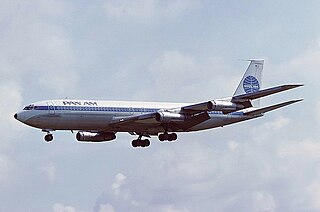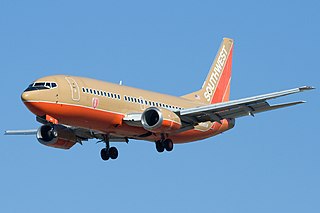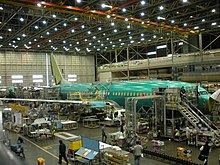
The Boeing 707 is an American, long-range, narrow-body airliner, the first jetliner developed and produced by Boeing Commercial Airplanes. Developed from the Boeing 367-80 prototype first flown in 1954, the initial 707-120 first flew on December 20, 1957. Pan American World Airways began regular 707 service on October 26, 1958. With versions produced until 1979, the 707 was a swept wing, quadjet with podded engines. Its larger fuselage cross-section allowed six-abreast economy seating, retained in the later 720, 727, 737, and 757 models.

The Boeing 727 is an American narrow-body airliner that was developed and produced by Boeing Commercial Airplanes. After the heavy 707 quad-jet was introduced in 1958, Boeing addressed the demand for shorter flight lengths from smaller airports. On December 5, 1960, the 727 was launched with 40 orders each from United Airlines and Eastern Air Lines. The first 727-100 rolled out November 27, 1962, first flew on February 9, 1963, and entered service with Eastern on February 1, 1964.

Renton is a city in King County, Washington, and an inner-ring suburb of Seattle. Situated 11 miles (18 km) southeast of downtown Seattle, Renton straddles the southeast shore of Lake Washington, at the mouth of the Cedar River. As of the 2020 census, the population of Renton was 106,785, up from 90,927 at the 2010 census. The city is currently the sixth-largest municipality in greater Seattle and the ninth-largest in Washington state.

The Boeing 737 is a narrow-body aircraft produced by Boeing at its Renton Factory in Washington. Developed to supplement the Boeing 727 on short and thin routes, the twinjet retains the 707 fuselage width and six abreast seating with two underwing turbofans. Envisioned in 1964, the initial 737-100 made its first flight in April 1967 and entered service in February 1968 with Lufthansa. The lengthened 737-200 entered service in April 1968, and evolved through four generations, offering several variants for 85 to 215 passengers.

The Boeing 757 is an American narrow-body airliner designed and built by Boeing Commercial Airplanes. The then-named 7N7, a twinjet successor for the 727, received its first orders in August 1978. The prototype completed its maiden flight on February 19, 1982 and it was FAA certified on December 21, 1982. Eastern Air Lines placed the original 757-200 in commercial service on January 1, 1983. A package freighter (PF) variant entered service in September 1987 and a combi model in September 1988. The stretched 757-300 was launched in September 1996 and began service in March 1999. After 1,050 had been built for 54 customers, production ended in October 2004, while Boeing offered the largest 737 NG variants as a successor.

The Boeing 717 is an American five-abreast single-aisle airliner produced by Boeing Commercial Airplanes. The twin-engine airliner was developed for the 100-seat market and originally marketed by McDonnell Douglas as the MD-95. It was a shortened derivative of the company's successful airliner, the MD-80, and thus the third generation of the DC-9 family. Capable of seating up to 134 passengers, the 717 has a design range of 2,060 nautical miles (3,820 km). It is powered by two Rolls-Royce BR715 turbofan engines mounted at the rear of the fuselage.

The Boeing E-6 Mercury is an airborne command post and communications relay based on the Boeing 707. The original E-6A manufactured by Boeing's defense division entered service with the United States Navy in July 1989, replacing the EC-130Q. This platform, now modified to the E-6B standard, conveys instructions from the National Command Authority to fleet ballistic missile submarines, a mission known as TACAMO. The E-6B model deployed in October 1998 also has the ability to remotely control Minuteman ICBMs using the Airborne Launch Control System. The E-6B replaced Air Force EC-135Cs in the Looking Glass role, providing command and control of U.S. nuclear forces should ground-based control become inoperable. With production lasting until 1991, the E-6 was the final new derivative of the Boeing 707 to be built.

The Douglas DC-8 is a long-range narrow-body airliner built by the American Douglas Aircraft Company. After losing the May 1954 US Air Force tanker competition to the Boeing KC-135, Douglas announced in July 1955 its derived jetliner project. In October 1955, Pan Am made the first order along with the competing Boeing 707, and many other airlines followed. The first DC-8 was rolled out in Long Beach Airport on April 9, 1958, and flew for the first time on May 30. FAA certification was achieved in August 1959 and the DC-8 entered service with Delta Air Lines on September 18.

A jet airliner or jetliner is an airliner powered by jet engines. Airliners usually have two or four jet engines; three-engined designs were popular in the 1970s but are less common today. Airliners are commonly classified as either the large wide-body aircraft, medium narrow-body aircraft and smaller regional jet.

The Boeing C-97 Stratofreighter was a long-range heavy military cargo aircraft developed from the B-29 and B-50 bombers. Design work began in 1942, the first of three prototype XC-97s flew on 9 November 1944, and the first of six service-test YC-97s flew on 11 March 1947. All nine were based on the 24ST alloy structure and Wright R-3350 engines of the B-29, but with a larger-diameter fuselage upper lobe and they had the B-29 vertical tail with the gunner's position blanked off. The first of three heavily revised YC-97A incorporating the re-engineered wing, taller vertical tail and larger Pratt and Whitney R-4360 engines of the B-50 bomber, flew on 28 January 1948 and was the basis of the subsequent sole YC-97B, all production C-97s, KC-97s and civilian Stratocruiser aircraft. Between 1944 and 1958, 888 C-97s in several versions were built, 811 being KC-97 tankers. C-97s served in the Berlin Airlift, the Korean War, and the Vietnam War. Some aircraft served as flying command posts for the Strategic Air Command, while others were modified for use in Aerospace Rescue and Recovery Squadrons (ARRS).
Pacific Western Airlines Ltd (PWA) was an airline that operated scheduled flights throughout western Canada and charter services around the world from the 1950s through the 1980s.

Boeing Commercial Airplanes (BCA) is a division of The Boeing Company. It designs, assembles, markets, and sells jet airliners and business jets, and also provides product-related maintenance and training to customers worldwide. BCA operates out of its division headquarters in Renton, Washington, and has more than a dozen engineering, manufacturing, and assembly facilities located throughout the United States and internationally. It includes the assets of the Douglas Aircraft division of the former McDonnell Douglas Corporation, which merged with Boeing in 1997. As of the end of 2021, BCA employed about 35,926 people.

Combi aircraft in commercial aviation are aircraft that can be used to carry either passengers as an airliner, or cargo as a freighter, and may have a partition in the aircraft cabin to allow both uses at the same time in a mixed passenger/freight combination. The name combi comes from the word combination. The concept previously existed in railroading, as a passenger car that contained a separate compartment for mail and/or baggage.

The Boeing 367-80, known simply as the Dash 80, is an American quadjet prototype aircraft built by Boeing to demonstrate the advantages of jet propulsion for commercial aviation. It served as basis for the design of the KC-135 tanker and the 707 airliner.

The Boeing 737 Classic is a series of narrow-body airliners produced by Boeing Commercial Airplanes, the second generation of the Boeing 737 series of aircraft. Development began in 1979 and the first variant, the 737-300, first flew in February 1984 and entered service that December. The stretched 737-400 first flew in February 1988 and entered service later that year. The shortest variant, the 737-500, first flew in June 1989 and entered service in 1990.

The Boeing 737 Next Generation, commonly abbreviated as 737NG, or 737 Next Gen, is a narrow-body aircraft powered by two jet engines and produced by Boeing Commercial Airplanes. Launched in 1993 as the third generation derivative of the Boeing 737, it has been produced since 1997 and is an upgrade of the 737 Classic (−300/-400/-500) series.

Boeing Plant 2 was a factory building which was built in 1936 by The Boeing Company in King County, Washington in the United States. By the time production ceased in the building, the plant had built half of the Boeing B-17 Flying Fortresses, the Boeing 307 Stratoliners, the Boeing 377s, some of the Boeing B-29 Superfortresses, Boeing B-50 Superfortresses, B-47 Stratojets, B-52 Stratofortresses, and the initial Boeing 737s. It was located between the Duwamish River and Boeing Field, to the east of the 16th Avenue South bridge, facing East Marginal Way South.

Southwest Airlines Flight 812 was a Boeing 737-300 passenger jet that on April 1, 2011, suffered rapid depressurization while cruising at 34,000 ft (10,000 m) near Yuma, Arizona, leading to an emergency landing at Yuma International Airport. Two of the 123 people on board suffered minor injuries. The aircraft was operating Southwest Airlines' domestic scheduled service from Phoenix, Arizona, to Sacramento, California.

This is the history of American aerospace manufacturing company Boeing.






















